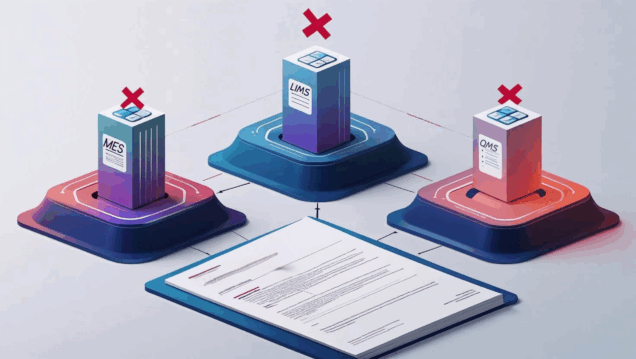Summary: Disconnected data silos make it hard to trace product histories and prepare for audits efficiently, leading to errors and delays. The solution is a Manufacturing Intelligence Platform, like Mareana, that connects all data sources, harmonizes the data, and act as a single source of truth to access audit-related information in real-time. This shift transforms audits from stressful, reactive events into streamlined, strategic opportunities for quality improvement and regulatory success.
In the highly regulated pharma manufacturing industry, audits are a non-negotiable reality. They are the cornerstone of robust quality assurance and a primary method for ensuring patient safety and product efficacy. However, for many organizations, the audit process remains a chaotic, time-consuming exercise. The culprit? Data silos.
Data silos are more than just an inconvenience; they are a fundamental obstacle to operational excellence. Data often resides in disconnected systems—MES, LIMS, ERP, and various legacy systems—that don’t communicate with each other. This creates a fragmented view of operations, making it incredibly difficult to trace a product’s history and prove compliance, a core requirement of regulatory bodies like the FDA and EMA. When an auditor arrives, the result is a frantic, manual scramble to pull information from various sources, leading to delays, increased risk of error, and a stressful experience for everyone involved. According to a study by the FDA, a significant portion of regulatory citations are related to issues with data integrity, highlighting the critical nature of this challenge.
What is the Impact of Siloed Data on Audits and CAPA Effectiveness?
The consequences of siloed data extend far beyond the audit itself. It cripples a company’s ability to perform effective corrective and preventive actions (CAPA). When a deviation occurs, investigating the root cause requires a holistic view of the manufacturing process. Without a single, unified data source, investigators are forced to piece together a fragmented narrative from disparate systems.
This not only lengthens the time to resolution but also increases the risk of addressing a symptom rather than the root cause. Data integrity across disparate systems is a major hurdle that leads to manual transcription errors, lack of standardization, and difficulties in accessing real-time, comprehensive data.
A report by the Aberdeen Group found that best-in-class companies are nearly twice as likely as their peers to have a centralized data and analytics platform, demonstrating the direct link between data integration and operational performance.
This is where the paradigm of data connectivity becomes a game-changer. Rather than treating each system as an isolated island of information, a unified manufacturing intelligence platform acts as a bridge, connecting data from all sources into a single, cohesive view.
This is the foundation of continuous audit readiness. By integrating real-time data from across the enterprise, a platform enables a proactive, risk-based auditing approach. For instance, rather than conducting routine, fixed-frequency audits, companies can use this unified data to identify and prioritize areas with the highest potential risk.
This strategic approach allows companies to optimize resources and focus on areas with the highest potential for impact on product quality and patient safety. The Mareana Manufacturing Intelligence Platform is designed to do precisely this. Mareana leverage this connected data to provide the comprehensive analytics needed to find the answers to all audit-related questions in minutes.
How Do You Achieve True Continuous Audit Readiness?
Achieving continuous audit readiness is not a simple matter of technology adoption; it’s a shift in culture and process. It begins with establishing a strong foundation of data connectivity. By bringing together information from MES, LIMS, QMS, and other systems, organizations can create a complete, tamper-proof digital thread for every batch. This digital record serves as an instantaneous and reliable source of truth, eliminating the need for manual data searches. A platform that centralizes data and automates workflows reduces audit preparation time and minimizes regulatory risk. Mareana’s platform enables a clear, transparent audit trail by seamlessly linking all relevant data points, from raw material to final product. This not only expedites the audit process but also builds a culture of quality where data is trusted, accessible, and used for proactive problem-solving. This shift allows teams to move from a reactive state of “audit preparation” to a state of ongoing, data-backed confidence.
Conclusion
The days of relying on manual, reactive audits are numbered. The complexity of today’s supply chains and the increasing emphasis on data integrity demand a smarter, more integrated approach. By addressing the root cause of audit inefficiencies—siloed data—pharmaceutical organizations can fundamentally transform their quality processes. A connected data platform allows for a seamless, transparent, and proactive approach to compliance, ensuring that audit readiness is not an event, but a continuous state. This not only reduces stress and costs but also frees up valuable resources to focus on what truly matters: driving innovation and ensuring patient safety.
Discover how the Mareana Manufacturing Intelligence Platform can help you achieve continuous audit readiness and transform your quality operations. Request a demo today.
Your next read: Cutting Audit Time from Days to Minutes: The Power of a Unified Data Platform
FAQs
What are the main challenges pharmaceutical companies face during audits?
Pharmaceutical companies often struggle with audits due to data silos across systems like MES, LIMS, ERP, and QMS. These disconnected systems lead to fragmented data, manual searches, and increased risk of errors, making audits stressful and inefficient.
How do data silos affect audit readiness?
Data silos prevent quick access to a complete product history and tamper-proof audit trails. This leads to last-minute scrambles during audits, delays in compliance verification, and heightened risk of regulatory findings.
Why is data integrity important in pharmaceutical audits?
Data integrity is crucial because it ensures that records are complete, consistent, and accurate. Regulatory bodies like the FDA often cite companies for data integrity issues, making it a top priority for compliance and audit readiness.
What is continuous audit readiness, and how can it be achieved?
Continuous audit readiness is a proactive, always-ready state of compliance enabled by integrating data from all manufacturing systems. It involves creating a tamper-proof digital thread for every batch, reducing audit prep time and ensuring real-time transparency.
How can a unified manufacturing intelligence platform improve audit outcomes?
A platform like Mareana’s connects disparate data sources into one system and harmonize the data using AI, allowing companies to automate workflows, identify risk areas, and streamline audit preparation. This leads to faster audits, fewer errors, and stronger regulatory compliance.
How does a digital thread support audit success?
A digital thread provides a complete, tamper-proof, batch-level record that links raw materials to final products. It enables seamless traceability, making it easier to demonstrate compliance during audits.
What is the FDA’s view on data integrity in audits?
The FDA frequently cites data integrity as a top compliance issue. Companies that lack robust, centralized, and secure data management systems are at higher risk of receiving warnings or citations during inspections.
How is the connected data approach different than the traditional approach to audits?
| Aspect | Traditional (Siloed Data) | Audit with Connected Data (Unified Platform) |
|---|---|---|
| Data Access | Manual, fragmented | Real-time, centralized |
| Audit Preparation Time | Long and stressful | Rapid and streamlined |
| Risk of Errors | High due to manual processes | Reduced via automation and traceability |
| CAPA Investigation | Symptom-focused, incomplete | Root-cause driven, comprehensive |
| Compliance Confidence | Low | High |




 Learn more
Learn more



